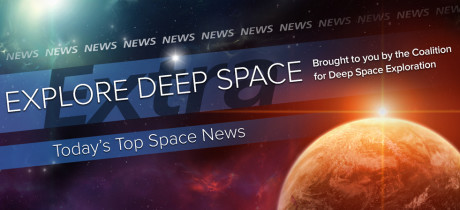In Today’s Deep Space Extra… NASA seeks bids for a second Space Launch System (SLS) mobile launch platform to hasten the early pace of launches of the new rocket with astronauts. Saturn’s moon Enceladus offers evidence of a possible habitable environment. The UAE and India bolster efforts to establish human space launch capabilities. The U.S. Space Force debate continues.
Human Space Exploration
NASA seeking proposals for second mobile launch platform
Space News (7/5): NASA has announced a two phase solicitation process for the acquisition of a second mobile launch platform for the Space Launch System (SLS) rocket as part of the ground support at the Kennedy Space Center. A contract to provide a second mobile launch that could help to hasten the pace of early SLS launches could be awarded in early February. A second mobile launcher could eliminate a multiyear need to modify the first and only mobile launcher in order to accommodate an upgrade of the Block 1 SLS with the more powerful Exploration Upper Stage for launches of Orion astronaut crews and modules for a human tended Gateway in lunar orbit. NASA’s 2018 spending bill included $350 million for a second MLP, which serves as a platform for stacking the large rocket in Kennedy’s Vehicle Assembly Building and transporting it to the launch pad for launch preparations, liftoff and re-use.
UAE astronaut programme: Final 18 chosen
Gulf Business (7/5): Following a series of evaluations to assess such attributes as intelligence, neurocognitive ability, personality and aptitude, among others, the United Arab Emirates has narrowed from 39 to 18 the number of candidates eligible to train for its astronaut corps. More assessments are planned, relying in part on experts from other space agencies, to select four flight candidates for flights spread over the next three years and starting with a Soyuz launch to the International Space Station in April 2019.
ISRO successfully tests astronaut escape feature
Deccan Herald (7/5): The Indian Space Research Organization on Thursday conducted its first pad abort test to demonstrate the crew escape system for an experimental crew capsule. The launch lofted the capsule to an altitude of about 8,800 feet for a parachute descent into the Bay of Bengal and recovery operations involving three boats. The uncrewed test was considered a milestone in India’s efforts to establish a human launch capability.
Space Science
Saturn’s moon Enceladus has conditions that could support microbial life
Spaceflightinsider.com (7/6): Data from the long running NASA/European Space Agency Cassini mission reveals complex organic molecules in the eruptive material rising from the south pole of Saturn’s icy ocean moon Enceladus. The assessment led by a German researcher and published in the journal Nature concludes that the moon has a potentially habitable environment. Cassini’s mission came to a close last year.
Something big crashed into Uranus and changed it forever
Space.com (7/5): The planet Uranus orbits the sun beyond Saturn, while uniquely rotating on its side, which has long puzzled astronomers. A new study suggests the reason is that the large greenish planet was struck by a relatively large planetary object about four billion years ago. A study led by a British researcher and published in the Astrophysical Journal reached the conclusion based on computer modeling.
Other News
Engine tests underway for DARPA spaceplane program
Coalition Member in the News – Aerojet Rocketdyne
Space News (7/3): A space shuttle era reusable main rocket engine is closing out 10 once per day test firings as part of a U.S. Defense Research Projects Agency effort to develop a space plane with a frequent flier capability. The Aerojet Rocketdyne engine shares a legacy with NASA’s Space Launch System (SLS) as well, including a new engine controller. The AR-22 engine is to power Boeing’s Phantom Express flight vehicle.
Wall Street Journal (7/4): The Journal’s editorial offers its opposition to the U.S. Space Force proposed by President Trump as a sixth branch of the military that would shoulder military space duties currently borne largely by the U.S. Air Force. The move would encourage costly duplication at a time when the military has other needs, according to the Journal.
WSJ says no to Space Force, while Trump promotes it again
Spacepolicyonline.com (7/6): The Washington space website offers an assessment of President Trump’s Space Force proposal, why he supports a sixth branch of the military dedicated to space defense and why others oppose it as well as a look back at the history of the concept.

